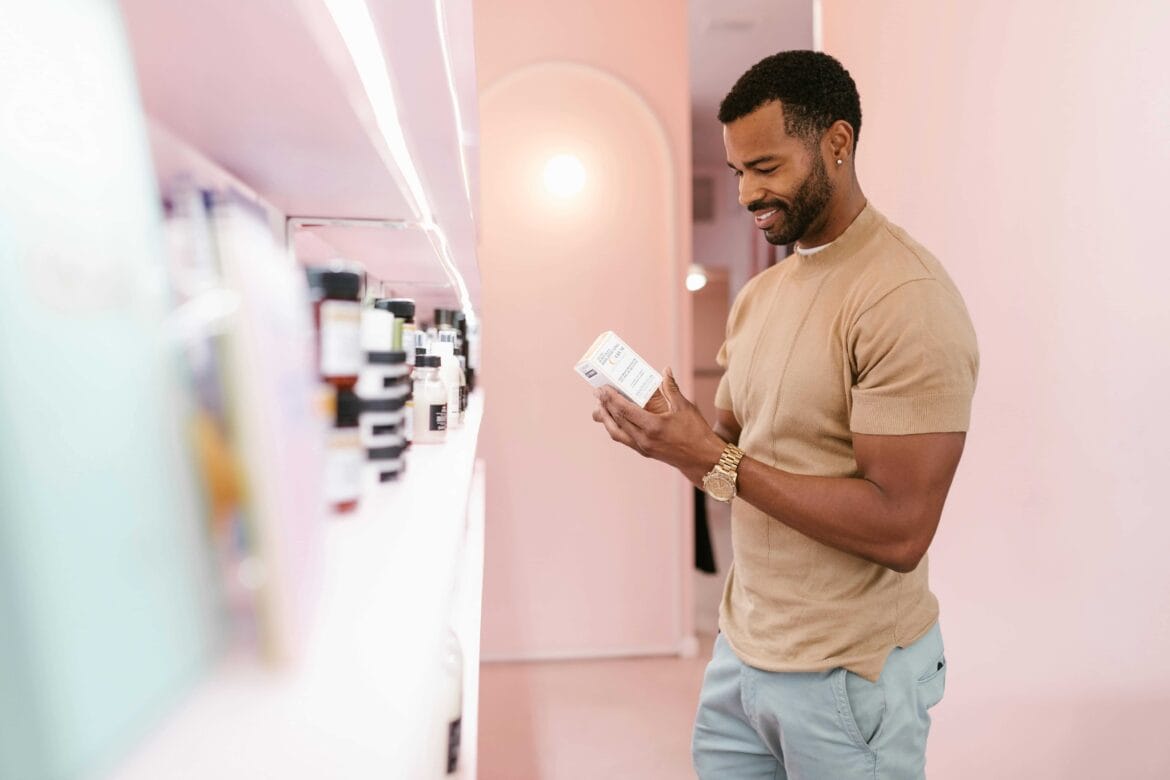Understanding Japanese skin care product labels can be tricky, but it’s the key to finding the perfect product for your needs.
We’ve all stood in front of a shelf of Japanese skin care products, beautiful packagings by the way, only to feel completely lost when trying to figure out what’s inside. We’ve been there—searching for a good moisturizer or cleanser but unable to read the ingredients or instructions.
That’s why we’ve made it our mission to break down these labels to you and help you chose that japanese beauty product you were looking for. Let’s make japanese skin care shopping easier, accessible, and stress-free.
If you want to skip directly to the japanese product label list with the Katakana, Romaji, meaning, and explanation, click the button below:
Let’s get started! In this article we will help you with:
- Decode Japanese skin care labels with a simple list of commonly used words translated into English.
- Learn to spot key ingredients for natural, moisturizing, or sensitive skin.
- Understand symbols and certifications for cruelty-free and organic products in Japan.
– Recognize product expiration dates and ensure safety.
– Read Kanji and Katakana to understand what’s in your products.
– Choose products confidently, whether you’re looking for paraben-free or alcohol-free options.
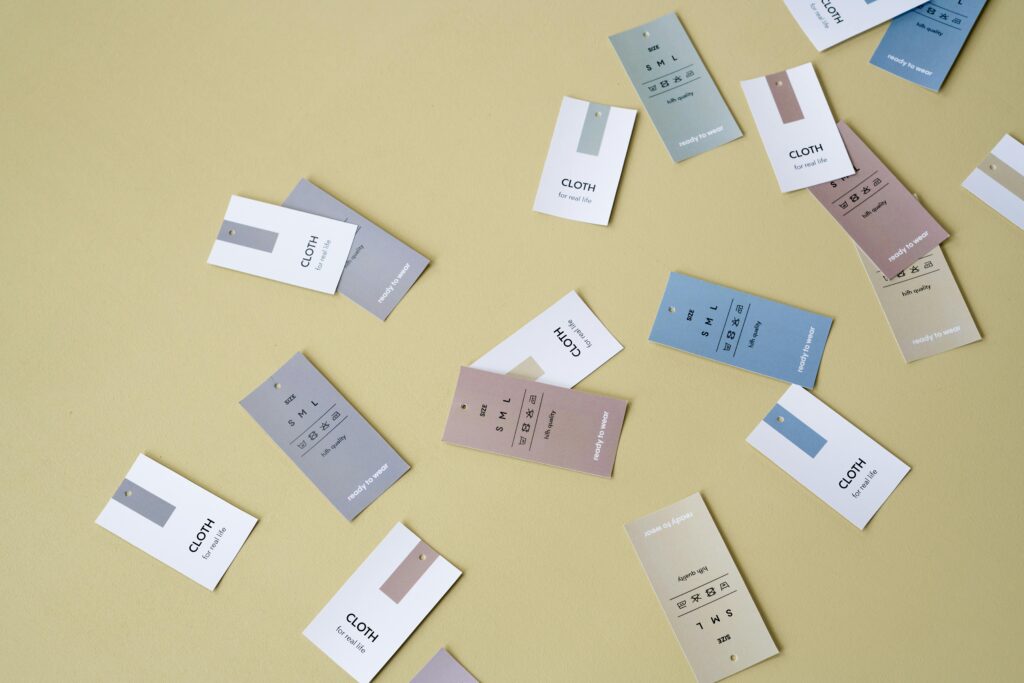
1. Understanding a Japanese skin care product label
Let’s be real—those beautiful Japanese skin care products can be overwhelming when you can’t read the labels. But here’s the thing: understanding them is the secret to finding your perfect match.
From what we’ve seen, symbols on Japanese beauty product labels are just as important. A small open jar icon indicates the product’s shelf life after opening. We always look for this to make sure products stay effective during use.
Our main advice is: learn some common Kanji and Katakana. Words like “水” (mizu) for water or “ヒアルロン酸” (hiaruronsan) for hyaluronic acid help us quickly identify the right products.
That’s why we have searched and well-crafted a list of the most used Kanji and Katakana words used in japanese beauty and japanese skin care product labels.
Some of these terms were selected by us, while others are sourced from this Reddit post. To ensure the content remains accurate and up-to-date, we’ve included them here for your convenience.
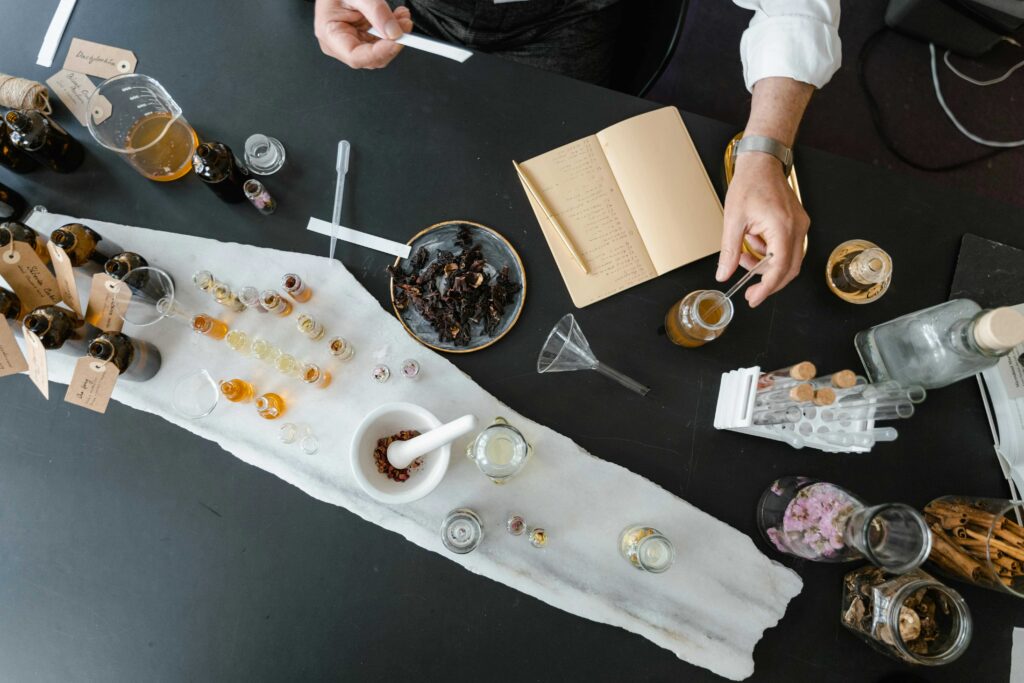
2. Ingredient Listing in Japanese Skin care Product Labels
2.1 Order of Ingredients and Their Significance
From what we’ve seen, the order of ingredients on Japanese skin care labels is listed from the highest concentration to the lowest.
Here’s how we evaluate products quickly. For example:
- If hyaluronic acid, glycerin, or ceramides appear in the top five ingredients, the product is likely great for boosting moisture.
- If alcohol is near the top, we test it carefully—especially if we have dry or sensitive skin.
Checking the first few ingredients has saved us from buying products that might not work for our skin type. It’s a small habit, but it makes a big difference!
2.2 Key Ingredients in Japanese Beauty Products
Japanese beauty products highlight active ingredients, often marked as “有効成分” (active ingredients), so you know exactly what they do. For example:
- Vitamin C derivatives (“ビタミンC誘導体”): Brighten skin and even out tone.
- Arbutin: Reduces dark spots and dullness.
- Zinc oxide (“酸化亜鉛”): Lightweight, broad-spectrum protection in sunscreens.
- Rice extract (“米エキス”): Hydrates and smooths skin.
- Green tea extract (“緑茶エキス”): Calms redness and protects against damage.
- Camellia oil (“椿油”): Deeply nourishes dry skin without heaviness.
- Konjac root: Gently exfoliates for a radiant finish.

3. Types of Japanese Beauty Product Labels
Japanese skin care product labels are grouped into three main categories, and knowing the difference makes shopping a whole lot easier. Here’s a quick breakdown:
- Medical Products (医薬品): These are highly regulated and designed for specific skin issues like acne or eczema. Look for active ingredients like tretinoin or salicylic acid. They include detailed usage instructions, so always check the label.
- Quasi-Drugs (医薬部外品): A mix of effectiveness and gentleness, these tackle concerns like pigmentation or mild acne. Common ingredients include arbutin (brightening) and tranexamic acid (reducing dark spots). Perfect for targeted skin care without being too harsh.
- Cosmetics (化粧品): Everyday products like moisturizers, cleansers, and sunscreens. They focus on quality and natural ingredients like hyaluronic acid and green tea extract. Great for maintaining healthy, glowing skin!
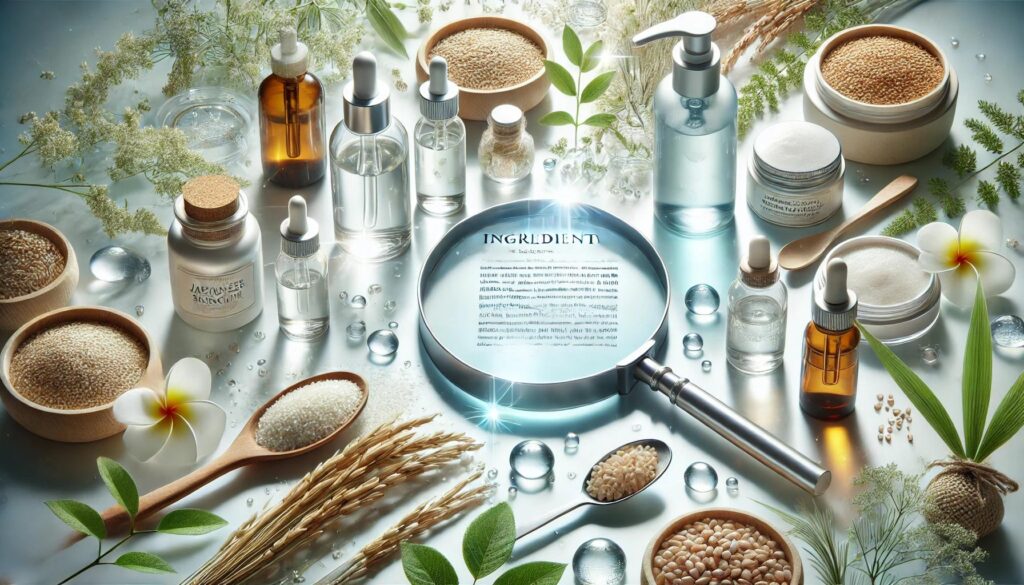
4. Expiration Dates, Certifications, and Safe Ingredients in Japanese Skin care
Paying attention to expiration dates is key to keeping your skin care safe and effective. Look for the open jar symbol with a number like “6M” or “12M”—this tells you how many months the product stays fresh after opening. Unopened products usually last up to three years if stored properly.
Certifications on Japanese skin care labels, like “医薬部外品” (Quasi-Drug), guarantee the product includes active ingredients for specific benefits, such as brightening or anti-acne.
You’ll also find “オーガニック” (organic) labels for eco-friendly and natural options, perfect for sensitive skin. Many brands now feature cruelty-free labels, too, which we value for ethical beauty.
For example, if you have sensitive skin, look for paraben-free and alcohol-free products. Paraben-free options avoid harsh preservatives, while alcohol-free products (labeled as “アルコールフリー”) skip ingredients like ethanol that can dry out your skin.

5. Sunscreen Labeling and SPF Standards
Japanese sunscreens are some of the best out there, and their labels make it easy to find exactly what you need. Here’s what to look for:
- SPF: Protects against UVB rays that cause sunburn.
- PA rating: Measures UVA protection. Look for “PA++++” for the highest defense against long-term damage and aging.
What we love most about Japanese sunscreens:
- They’re super lightweight and often double as skin care with ingredients like aloe vera or hyaluronic acid to keep skin hydrated.
- There’s a sunscreen for everyone—water-resistant options for outdoor fun or clear gels that layer perfectly under makeup.
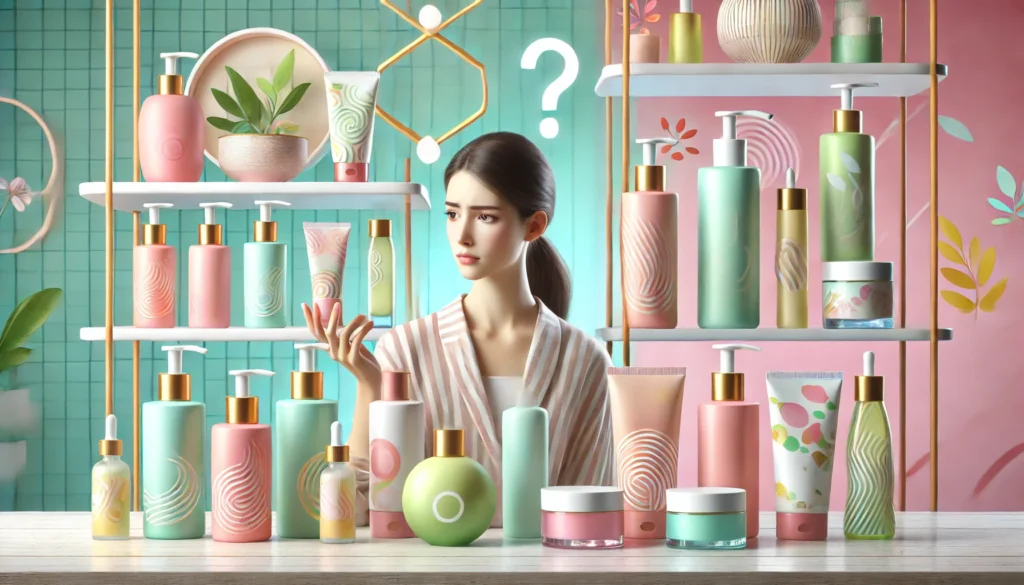
6. Practical Tips for Reading Japanese Skin care Product Labels
Understanding Japanese skin care labels doesn’t have to be hard. Here are some tips to make it easier:
- Identify brands: Look for names in Katakana, like “ハダラボ” (Hada Labo). Minimalist designs and logos, like “資生堂” (Shiseido), are also great clues.
- Decode ingredients: Learn key kanji, like “水” (water) and “油” (oil), and common Katakana terms, such as “ヒアルロン酸” (hyaluronic acid). Apps like Google Lens are perfect for quick translations.
- Use trusted resources: Sites like Cosme.net and forums on Reddit’s J-beauty community offer reviews and advice. These are goldmines for finding the best products.
With these tools and a little practice, you’ll feel confident navigating Japanese skin care product labels and picking products that truly work for your skin.

7. Japanese Beauty Label Word List
Here’s a list of common Japanese skin care product labels terms, their translations, and brief explanations to help you navigate product labels:
- All-in-one / オールインワン / ōru in wan
- Products that combine steps like toner, serum, and moisturizer into one. Saves time and effort!
- Aloe vera / アロエベラ / aroe bera
- A soothing ingredient that helps calm the skin and keep it hydrated.
- Amino collagen / アミノ コラーゲン / amino korāgen
- Collagen with amino acids. Keeps skin firm and moisturized.
- Aqua / アクア / akua
- Water-based products. Light and great for hydration.
- Arbutin / アルブチン / arubuchin
- A brightening ingredient that helps reduce dark spots and uneven skin tone.
- Base / ベース / bēsu
- Primers or base products applied before foundation to even out the skin.
- Base makeup / ベースメイク / bēsu meiku
- Products like primers, foundations, or powders that create a smooth, even look.
- Basic/simple / シンプル / shinpuru
- Minimalist skin care, good for sensitive or fuss-free routines.
- BB cream / BBクリーム / BB kurīmu
- A product that works as foundation, moisturizer, and sunscreen in one.
- Beauty / ビューティ / byūti
- A general term for beauty products or services.
- Body / ボディ / bodi
- Refers to products for body care, like lotions or washes.
- Body scrub / ボディスクラブ / bodi sukurabu
- Exfoliating products that remove dead skin cells for smoother skin.
- Brand / ブランド / burando
- The name of the company or label making the product.
- Breast / バスト / basuto
- Products designed to firm or care for the bust area.
- Brush / ブラシ / burashi
- Makeup brushes or applicators for easy product use.
- Care / ケア / kea
- A term for products related to skin, hair, or general beauty care.
- Cleansing cream / クレンジングクリーム / kurenjingu kurīmu
- A rich cream that removes makeup and cleans the skin.
- Cleansing gel / クレンジングジェル / kurenjingu jeru
- A gel-based cleanser that feels light and refreshing.
- Cleansing milk / クレンジングミルク / kurenjingu miruku
- A gentle, milky cleanser perfect for dry or sensitive skin.
- Cleansing oil / クレンジングオイル / kurenjingu oiru
- An oil-based cleanser that removes makeup, sunscreen, and dirt easily.
- Cream / クリーム / kurīmu
- A general term for creams, usually for hydration and nourishment.
- Cream eyeshadow / クリームアイシャドウ / kurīmu ai shadō
- Eyeshadow in a creamy texture that blends smoothly.
- Coenzyme Q10 / コエンザイムQ10 / koenzaimu Q10
- An antioxidant often used in anti-aging products to reduce wrinkles and improve skin elasticity.
- Concealer / コンシーラー / konshīrā
- A makeup product used to cover blemishes, dark circles, and other imperfections.
- Conditioner / コンディショナー / kondishonā
- A hair care product that softens and detangles hair after shampooing.
- Cool / クール / kuuru
- Refers to products with a cooling effect, often refreshing on the skin.
- Cotton / コットン / kotton
- Used for applying toner, removing makeup, or cleansing the skin.
- Deodorant / デオドラント / deodoranto
- Products to control sweat and body odor, available as sprays, sticks, or roll-ons.
- Dimethicone / ジメチコン / jimechikon
- A silicone-based ingredient that smooths and protects the skin’s surface.
- Dolly Wink / ドーリーウインク / dōrī uinku
- A popular Japanese brand known for false eyelashes and eye makeup.
- Drink / ドリンク / dorinku
- Refers to beauty drinks or supplements, often aimed at improving skin or health.
- Essence / エッセンス / essensu
- A lightweight, hydrating skin care step, similar to a serum.
- Essence or serum / 美容液 (びようえき) / biyōeki
- Skin care products concentrated with active ingredients for targeted care.
- Eye care / アイケア / ai kea
- Products specifically for the delicate skin around the eyes, such as creams or serums.
- Eye cream / アイクリーム / ai kurīmu
- Hydrating creams designed to reduce puffiness, dark circles, and fine lines around the eyes.
- Eye liner / アイライナー / ai rainā
- A makeup product used to define and enhance the eyes.
- Eyeshadow / アイシャドウ / ai shadō
- Colored makeup for the eyelids, available in powder, cream, or liquid form.
- Film / フィルム / firumu
- Refers to film-forming products like certain sunscreens or mascaras that create a protective layer.
- Foam / フォーム / fōmu
- Light, airy cleansers that lather to gently clean the skin.
- Foot / フット / futto
- Products for foot care, like scrubs or creams to soften and smooth feet.
- Foot care / フットケア / futto kea
- Refers to products or tools specifically for maintaining healthy feet.
- Foundation / ファンデーション / fandēshon
- A makeup base that evens skin tone and creates a smooth canvas for other products.
- Fragrance / フレグランス / fureguransu
- Perfumes or scented products to enhance personal aroma.
- Glycerin / グリセリン / guriserin
- A hydrating ingredient that draws moisture into the skin.
- Gold / ゴールド / gōrudo
- Often found in luxury skin care, it’s said to have anti-aging and brightening effects.
- Gommage / ゴマージュ / gomāju
- A gentle exfoliating product that removes dead skin cells for a smoother look.
- Goods / グッズ / guzzu
- A general term for accessories or tools related to beauty, like puffs or makeup bags.
- Hada Labo / ハダラボ / hada rabo (肌研)
- A famous Japanese skin care brand known for hydrating and gentle products.
- Hair / ヘア / hea
- Refers to hair care products like shampoos, conditioners, and styling items.
- Hair mask / ヘアマスク / hea masuku
- Deep conditioning treatments that restore and nourish damaged hair.
- Hair pack / ヘアパック / hea pakku
- Another term for intensive hair treatments, often left on for several minutes before rinsing.
- Hair styling / ヘアスタイリング / hea sutairingu
- Products used to style and hold hair, like gels, waxes, and sprays.
- Hand / ハンド / hando
- Refers to hand care products or items designed for use on hands.
- Hand cream / ハンドクリーム / hando kurīmu
- Moisturizers specifically for keeping hands soft and hydrated.
- Hyaluronic (acid) / ヒアルロン酸 / hiaruron-san
- A popular ingredient that hydrates skin by attracting and retaining moisture.
- Ice / アイス / aisu
- Often refers to cooling products that refresh the skin.
- Item / アイテム / aitemu
- A general term for a product or accessory.
- Jojoba (oil) / ホホバ油 / hohoba-yu
- A nourishing oil used for moisturizing and balancing skin.
- Kit / キット / kitto
- Sets of products sold together, like skin care or makeup starter kits.
- Lemon / レモン / remon
- Often used for its brightening and refreshing properties.
- Lemon extract / レモンエキス / remon ekisu
- An ingredient known for toning and clarifying the skin.
- Leg / レッグ / leggu
- Refers to leg care products, such as moisturizers or exfoliators.
- Liner / ライナー / rainā
- A makeup product used to outline and define eyes or lips.
- Liquid / リキッド / rikiddo
- A term for liquid-based products, such as foundations or eyeliners.
- Lip / リップ / rippu
- Refers to lip products, including balms, glosses, and lipsticks.
- Lip balm / リップクリーム / rippu kurīmu
- A moisturizing product for keeping lips soft and hydrated.
- Lip care / リップケア / rippu kea
- General term for products to care for lips, including balms and exfoliators.
- Loose powder / ルースパウダー / rūsu paudā
- A light powder used to set makeup or reduce shine.
- Lotion or emulsion / 乳液 (にゅうえき) / nyūeki
- Lightweight moisturizers that hydrate the skin without feeling heavy.
- Makeup / メイク / meiku
- A general term for beauty products used to enhance appearance.
- Mascara / マスカラ / masukara
- A makeup product used to lengthen and darken eyelashes.
- Mask / マスク / masuku
- Products like sheet masks or clay masks used for skin care treatments.
- Massage / マッサージ / massāji
- Products or techniques that promote relaxation and improve circulation.
- Milk / ミルク / miruku
- Light, milky-textured products for moisturizing and cleansing.
- Oil / オイル / oiru
- A product used for hydration, cleansing, or nourishing the skin.
- Oral / オーラル / oraru
- Refers to oral care products like toothpaste or mouthwash.
- Pack / パック / pakku
- Skin care treatments like face masks or sheet masks.
- Paraben / パラベン / paraben
- A preservative used in skin care. Look for “paraben-free” labels if you prefer alternatives.
- Moisture/hydrating toner / 化粧水 / けしょうみず / keshoumizu
- A lightweight liquid used to hydrate the skin and prepare it for other products.
- Essence/serum / 美容液 / びようえき / biyoueki
- A concentrated skin care product packed with active ingredients for targeted care, like brightening or anti-aging.
- Lotion/emulsion / 乳液 / にゅうえき / nyuueki
- A lightweight moisturizer that locks in hydration without feeling heavy.
- Moisturizing toner / 化粧水 / けしょうすい / keshousui
- Another term for hydrating toner that adds moisture to the skin before essence or serums.

8. Conclusion
Being able to read Japanese skin care product labels is essential in creating a personalized and effective japanese skin care routine.
By understanding the types of labels—whether medical products, quasi-drugs, or cosmetics—you can choose products tailored to your specific needs.
We’ve shared practical tips for identifying trusted Japanese skin care brands, translating ingredient lists, and given you the most common words in japanese to look for when shopping japanese skin care products.
We’re confident that with a bit of practice, you’ll navigate Japanese skin care product labels like a pro and discover the perfect products for your unique needs.
FAQ
What are the labeling requirements for beauty products in Japan?
All Japanese beauty products must list their ingredients in descending order of concentration, include any active ingredients, and display symbols for safety information such as expiration dates and certifications like “医薬部外品” (Quasi-Drug) for functional products.
What are the four types of product labels in Japan?
The four main label types are “医薬品” (Medical Products) for treatments, “医薬部外品” (Quasi-Drugs) for targeted skin concerns, “化粧品” (Cosmetics) for general beauty products, and “食品” (Food Products) when it comes to ingestible beauty items like supplements.
Why do Japanese products use English on their labels?
English is often used on Japanese beauty labels to make the products more appealing and understandable to international customers, while still retaining key ingredient and certification information in Japanese for compliance with regulations.
How to identify organic certification on Japanese products?
Look for labels like “オーガニック” or certifications from third-party organizations such as JAS (Japanese Agricultural Standard), which verify the use of organic, eco-friendly ingredients in the product.
How to spot expiration dates on Japanese skin care products?
Check for the open jar symbol indicating months of usability after opening (e.g., “6M” or “12M”), and for unopened products, find a printed date or batch code on the packaging.
Table of Contents
